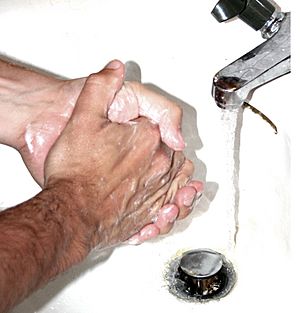Hand washing facts for kids
Hand washing means cleaning your hands with water and soap or other special liquids. We do this to remove dirt, germs, and harmful substances. Germs and harmful substances can cause diseases and other health problems. Germs are tiny living things like bacteria, viruses, or fungi. Some diseases caused by germs cannot be cured by antibiotics. Washing your hands helps stop many diseases from spreading. It is very important to wash your hands before cooking or touching food.
Contents
When to Wash Your Hands
It's important to wash your hands often to stay healthy. Here are some key times you should always wash your hands:
- After using the toilet or going to the bathroom.
- After touching an animal or a pet, like a dog, cat, or turtle.
- Before and after touching or helping someone who is sick.
- Before preparing or cooking any food.
- After touching uncooked meat, fish, or poultry (like chicken or turkey). Some uncooked foods can carry germs.
- Before eating to prevent germs from getting into your food.
- After blowing your nose or sneezing into your hand.
How to Wash Your Hands Properly
Washing your hands correctly helps remove the most germs. Follow these steps for clean hands:
- Use soap and warm, running water.
- Wet your hands and then add soap.
- Rub your wet hands together strongly with soap for at least 20 seconds. Make sure to rub all parts of your hands.
- Clean any dirt from under your fingernails.
- Rinse your hands well under running water to remove all the soap.
- Dry your hands using a clean cloth or a paper towel.
- If you wash your hands many times a day, use moisturizing lotion so your hands do not get too dry.
Hand Washing for Healthcare Workers
For people who work in healthcare, like doctors or nurses, hand washing is even more critical. Not washing hands before touching each new person can be very dangerous. They use extra soap and water and rub every part of their hands carefully. They also rub between each finger. Sometimes, they use a brush to clean under their fingernails. After washing, they rinse their hands thoroughly and dry them with a paper towel.
For a surgery, healthcare workers do a special, very thorough hand wash called a "surgical scrub." This needs special water taps that can be turned on and off without touching them. They use strong cleaning liquids like "chlorhexidine" or "iodine wash." They also use a sterile cloth for drying and a sterile brush for hard scrubbing. "Sterile" means completely free of germs. Before scrubbing, they take off all watches, rings, and other jewelry. They wash their hands and arms up to their elbows very carefully and strongly. They keep their hands up so water does not drip from their arms back onto their clean hands. After drying with a sterile cloth, they put on a special surgical gown.
Related Pages
Images for kids
-
A community handwashing facility in Rwanda with sinks for people of different heights. During the COVID-19 pandemic in Rwanda handwashing was part of a system of public health measures encouraged to reduce transmission.
-
Electronic sign inside a Washington Metro station during the COVID-19 pandemic
-
Tsukubai, provided at a Japanese temple for symbolic hand washing and mouth rinsing
See also
 In Spanish: Higiene de manos para niños
In Spanish: Higiene de manos para niños









